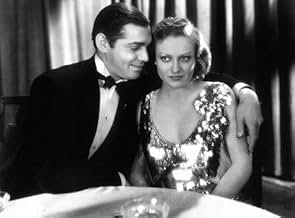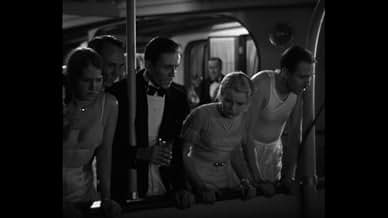अपनी भाषा में प्लॉट जोड़ेंAfter the death of her father and loss of the family fortune, Bonnie (Joan Crawford) gets a job as a cub reporter while her brother (William Bakewell) becomes involved in bootlegging.After the death of her father and loss of the family fortune, Bonnie (Joan Crawford) gets a job as a cub reporter while her brother (William Bakewell) becomes involved in bootlegging.After the death of her father and loss of the family fortune, Bonnie (Joan Crawford) gets a job as a cub reporter while her brother (William Bakewell) becomes involved in bootlegging.
- पुरस्कार
- कुल 1 जीत
- Wally
- (as Earl Foxe)
- Parker
- (as Purnell B. Pratt)
- Luva's Henchman
- (बिना क्रेडिट के)
- Albert
- (बिना क्रेडिट के)
- Yacht Waiter
- (बिना क्रेडिट के)
- Clinton
- (बिना क्रेडिट के)
- Chorus Girl
- (बिना क्रेडिट के)
- Reporter
- (बिना क्रेडिट के)
फ़ीचर्ड समीक्षाएं
But none of this is supposed to be taken seriously - it's all good fun from those wonderful pre-code days, when Hollywood was really naughty. Joan looks great, and displays much of the emotional range that would give her career such longevity (thank God she stopped the dancing!). Gable is remarkable as a slimy gangster - he wasn't a star yet and so didn't have to be the hero. Great to see him playing something different. And William Bakewell is excellent as the poor confused brother. And there are some great montages and tracking shots courtesy of director Harry Beaumont, who moves the piece on with a cracking pace - and an occasional wink to the audience! Great fun!
The film is largely an unremarkable morality tale about the follies of the very wealthy spoiling their children even into adulthood to the point where they complain about having to "get up in the middle of the night (9 AM) to eat breakfast.", which are the sentiments of the two Jordan children. When Wall Street crashes, dad dies from the shock and Bonnie Jordan (Joan Crawford) and her brother are left penniless. Bonnie chooses to break into newspaper reporting, but her brother chooses a less honest option which brings him into contact with Gable the gangster. After her close friend, reporter Bert Scranton (Cliff Edwards), is shot to death, Bonnie decides to go undercover as a dancer at Gable's nightclub to try to get to the bottom of the murder. She solves the crime, but at great personal cost.
The best parts of this film are watching Joan Crawford in a dance number and watching the great chemistry Crawford and Gable have together. You get bigger doses of Crawford and Gable together in "Possessed", which was made later this same year - 1931. Joan Crawford was already a big star at this point. As for Clark Gable, he has to wait until he manhandles Norma Shearer in "A Free Soul" before he catapults to true stardom.
You can probably guess what I love about Crawford's character. She's a modern woman who looks great out on the dance floor, believes in "trying love out on approval" (a scene which clearly signals pre-marital sex), and would rather work and be independent than settle for the traditional role of wife. Her brother is incredulous, leading to this exchange:
Bonnie (Crawford): "I'm not going to do any of those stupid, silly, conventional things. You'd be surprised what a girl can earn when she sets her mind to it. I'm no dud." Rodney (Bakewell): "You've got the looks, kid. Trade on 'em. Open up a beauty parlor. ..." Bonnie: "That's your idea of me, huh? Beautiful but dumb. All right, I'll show you. I'm going out to get a man-sized job."
That second dance she does when she's working undercover in the gangster's nightclub to get a story is delightful and evokes the flapper era, but to me the feminism in the film is what makes it a solid film, despite its basic plot. Crawford is not known for her on-screen charm, but she summons it here, and does well in the various aspects of her role - society woman, flapper, newspaper reporter, and love interest (hey, the complete woman). Gable is suitably tough as the gang leader, and he and Crawford have great chemistry together. I didn't care for the contrived confrontation which occurs and how the film ends though, which was really unfortunate, and kept it from a higher rating.
Another quote, from Gable to Crawford after her dance: "You got me going, sister." "Can I depend on it?" "In a big way."
Middle-of-the-road crime drama will appeal most to fans of Crawford and Gable. It's hardly the best work of either, though. It's a pre-Code film, which sometimes is all you have to say to get some classic film fans interested in a movie. Personally I didn't see anything all that risqué in this one. An early scene of a bunch of people in their underwear going for a swim seems to get the most talk but it's pretty tame despite the description. The story is something that was done many times and better over the years, in one variation or another. The insipid romance between Joan and Lester Vail leaves a lot to be desired.
In the 30s, Hollywood had a knack for churning out one entertaining *and* enlightening audience-pleaser after another, all without wasting a frame of film. Dance, Fools, Dance -- one of *four* films that Harry Beaumont directed in 1931 -- is barely 80 minutes long, yet its characters are well developed, its story never seems rushed, and despite its many twists in plot, the audience is never left behind.
With the lone exception of Lester Vail as flaccid love interest Bob Townsend, the supporting cast is uniformly strong. Worthy of note are William Bakewell as Crawford's brother, Cliff Edwards (best known as the voice of Jiminy Cricket) as reporter Bert Scranton, and Clark Gable in an early supporting role as gangster Jake Luva.
But this is Joan Crawford's film, and she absolutely shines in it. Made when she was just 27, this lesser-known version of Crawford will probably be unrecognizable to those more familiar with her later work. However, here is proof that long before she took home an Oscar for Mildred Pierce, Crawford was a star in the true sense of the word, a terrific actress with the charisma to carry a picture all by herself.
Score: EIGHT out of TEN
क्या आपको पता है
- ट्रिविया"Dance, Fools, Dance" is clearly based on two infamous incidents in Chicago crime history: the 1929 St. Valentine's Day Massacre in a garage and the June 9, 1930 murder of Chicago Tribune reporter Jake Lingle, who was shot while heading to a train station. However, unlike the movie's Bert Scranton, Lingle was a shady character who played both sides of the law and had parlayed a $65 a week salary into a $60,000 income. In journalistic terms, Lingle was known as a legman who would telephone in the salient details of the story which would be actually written by a rewrite man. This is what happens when Joan Crawford's Bonnie phones in her story after the shootout.
- गूफ़When in the newsroom Scranton tells Bonnie that if they had a chance they would cut the Lord's Prayer to a one-line squib and he quotes, "Now I lay me down to sleep". But the line is not from the Lord's Prayer, it is actually the first line and title of the bedtime prayer, "Now I Lay Me Down To Sleep".
- भाव
Bob: You know I'm very much in love with you, don't you?
Bonnie: Are you?
Bob: I'm crazy about you, and you know it.
Bonnie: I didn't know.
Bob: Well, you know it now. What about it?
Bonnie: That's it... what?
Bob: Going to make me stand on ceremony?
Bonnie: You think I'm so old-fashioned?
Bob: I hope not.
Bonnie: You're right. I'm not. I believe in... in trying love out.
Bob: On approval?
Bonnie: Yes, on approval.
[they kiss as the scene fades out]
- कनेक्शनEdited into Hollywood: The Dream Factory (1972)
- साउंडट्रैकPiano Sonata No. 14 in C sharp minor, Op. 27 No. 2 'Moonlight'
(1800-01) (uncredited)
Written by Ludwig van Beethoven
Played on piano by Natalie Moorhead
Reprised on piano by Joan Crawford in a swing version
टॉप पसंद
विवरण
- रिलीज़ की तारीख़
- कंट्री ऑफ़ ओरिजिन
- भाषा
- इस रूप में भी जाना जाता है
- Plesačica Boni
- फ़िल्माने की जगहें
- उत्पादन कंपनी
- IMDbPro पर और कंपनी क्रेडिट देखें
बॉक्स ऑफ़िस
- बजट
- $2,34,000(अनुमानित)
- चलने की अवधि1 घंटा 20 मिनट
- रंग
- पक्ष अनुपात
- 1.20 : 1
इस पेज में योगदान दें




































